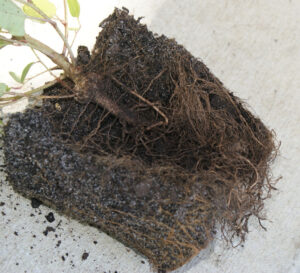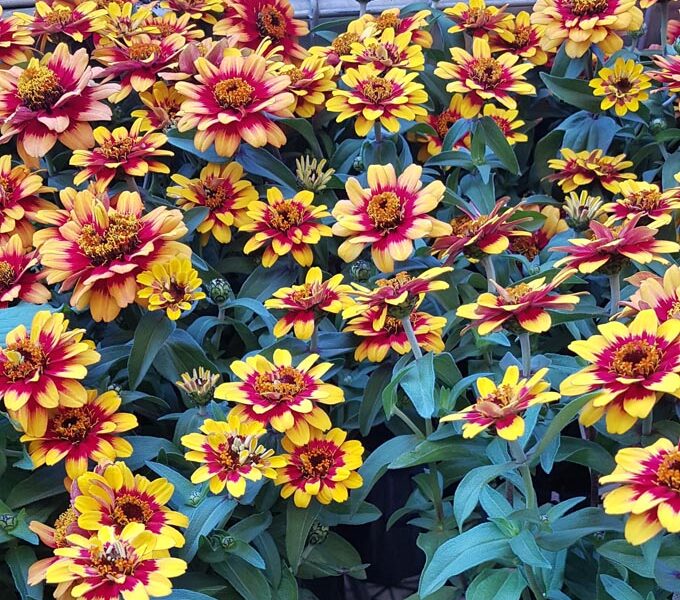Plant nutrition: What, when, how, why
By John Fitzsimmons
Recent times have seen a rise in consumer concerns not just with ‘what’ they are buying but ‘how’ it was produced. Buying preferences have been increasingly flowing to ‘natural’, ‘organic’, ‘green’, ‘safer’, and ‘environmentally friendly’ labels. While the concepts are appealing it’s also easy to become a bit cynical about the real claims and benefits of some proliferating labels. What can it mean for greenlife and plant nutrition?
Throughout history people have been concerned with food – usually its availability or lack thereof. Recently, quality became more of an issue. And now, while much of the world has access to adequate volumes of nutrition – economic or political barriers aside, we live in times where increasing numbers of (mainly Western) people are concerned with the ethics of production – of food, of fibre, and the sustainability of energy and durables. Those concerns have ultimately reached their gardens, and the suppliers of greenlife and gardening inputs.

At both industry wholesale and retail levels the offering of such products, greenlife, especially seedlings, pest and disease treatments, and plant nutrition products, is significant and expanding. Entire industries, enterprises, and careers have been built on this situation. Most people have limitations with the expansive chemistry and biology involved. So how do you cut through all the claims, counter-claims, and labelling?
First a caution; state consumer bodies and the likes of the federal ACCC (Australian Competition and Consumer Commission) are keeping an increasingly close eye on the use of such terms as ‘safe’, ‘natural’, and ‘organic’ in labelling and advertising. Likewise, accredited bodies such as ACO and NASAA (Australian Certified Organic, and National Association for Sustainable Agriculture Australia) are very protective of their domains and members. So, commercially, do not use such wording on labels or in marketing without appropriate validations.
Let’s just consider one sector and a couple of common descriptors – organic and natural.
To the industrial chemist there can be a simple and clear delineation – inorganic chemicals contain no carbon, and organic chemicals do contain carbon. There are some pretty dangerous compounds on both sides of that fence.

But in the eyes of the layman consumer, ‘organic’ has more ‘natural’ and benign connotations and can be more readily acceptable or even preferred. ‘Organic’ is also often associated with ‘plant-based’ but that idea is not always extended to the leaves of rhubarb which contain concentrations of oxalic acid which can shut down your kidneys, the nicotine and anabasine poisons in tobacco, or the cardiac glycosides in beautiful Lilly of the Valley flowers.
Even using the ubiquitous caffeine-rich coffee grounds as a soil improver or ‘fertiliser’ has been shown to be phytotoxic for some species (e.g. rosemary, pothos, and some orchids) at certain levels, while others do seem to benefit or even thrive (e.g. blueberry, cabbage, azaleas). Depending on the quantity applied and method of incorporation into the soil, coffee grounds can also either improve soil structure or create a water-repellent crust. They can, however, be a low-cost source of nitrogen.
Whether in beds, paddocks or pots, feeding plants comes down to just what nutrients each plant needs, what is present versus what can be accessed, and the needed and accessible quantities. Most horticulturists are familiar with the 17 essential plant nutrients, whereas there are more than 100 elements in soil that, at times, might play some role in supporting plant life.
PLANT NUTRIENTS & SOME NOTES
| Hydrogen Source: water, air or both | Oxygen Source: water, air or both | Carbon Source: water, air or both |
| N – Nitrogen Source: rootzone, mineral nutrients | P – Phosphorus Source: rootzone, mineral nutrients | K – Potassium Source: rootzone, mineral nutrients |
| Calcium Source: rootzone, mineral nutrients | Magnesium Source: rootzone, mineral nutrients | Sulfur Source: rootzone, mineral nutrients |
| Chlorine ome plants sensitive to deficiency: lettuce, potato, carrot, spinach | Molybdenum Plants sensitive to excess: legumes Some plants sensitive to deficiency: brassicas, legumes | Iron Some plants sensitive to deficiency: citrus, grapes |
| Boron Source: rootzone, mineral nutrients Some sensitive plants: brassicas, legumes and medics, pome fruit, potato, celery tomato, cucumber | Copper Source: rootzone, mineral nutrients Some sensitive plants: onions, watermelon, sunflower, spinach | Nickel Source: rootzone, mineral nutrients Some sensitive plants: cereals |
| Zinc Plants sensitive to excess: spinach Some plants sensitive to deficiency: legumes, grapes, citrus | Manganese Plants sensitive to excess: potato, cabbage Some plants sensitive to deficiency: fruit trees | Sodium, Silicon, Cobalt, Selenium Not essential but beneficial for some species |
Nearly 40% of the plant dry weight is carbon. Plants get their required carbon from existing carbon dioxide in the air and most of this gas enters the plant through the leave’s stomata when they are open. When carbon dioxide (gas) enters plant cells, the energy of sunlight is converted via photosyntheis to carbohydrates (sugars). The carbohydrates produced are transferred to other parts of the plant contributing to the construction of other plant material
You will note that in most cases the plant takes up nutrients in inorganic form. Nutrients taken up may have been converted from organic sources by chemical activity or biological agents in the soil. This is why some soil tests might suggest that there are adequate quantities of a nutrient present in the soil but it may not be accessible to the plant. Most farmers are familiar with ‘nitrogen lock-up’ following a nitrogenous application, as an example.
Hydroponic growing, in contrast, broadly aims to short-circuit this system and provide plants with the desired nutrient combination/s for ready uptake from liquid solutions. While highly efficient in nutrient and water utilisation, the hydroponic idea is often anathema to ‘organic’ growers because of its essentially inorganic basis.
Consider a perspective attributed to Roger H. Thayer and Hydroponic University: “Inorganic chemistry deals with non-living materials. Organic chemistry focuses on the carbon and carbon-containing compounds typically associated with life. Biologists and botanists who deal with the life scientists are stuck in the middle … when they talk to the farmer or gardener they have to talk in different terms; to them ‘organic’ means ‘natural’ not carbon-based. They can say one thing but really mean something else.”

To continue: “There is no difference between an atom, mineral, or element itself. What matters is whether or not they are in a form that is non-harmful and can be used by plants. If so, they are beneficial whether natural or man-made.”
Because plants get all the carbon they need from CO2 in the air, the term ‘organic gardening’ can be confusing.
“The same minerals are needed in either hydroponic or organic growing. These minerals are provided to plants in an organic garden as they are released from organic matter by the action of microbes, invertebrates, and bacteria. In hydroponics the same elements are provided by water soluble mineral salts.”
Those mineral salts can be naturally derived (‘as natural as the earth itself’) or man-made, that are then processed to produce compounds with a definite molecular structure and composition – the chemical composition is precisely known (so) hydroponic methods eliminate much of the uncertainty and guesswork found in organic growing.

However, using the technical definition, many chemical nutrient formulae (e.g. chelated trace elements and urea) could be considered ‘organic’.
As Thayer summarises: “The important point is it is not the elements that are different … it is how these elements are obtained and delivered to the plant.”
Perhaps that explains they key difference in perceptions between the organic/natural school of nutrition and others.
There are contradictions and caveats on all sides. As Dr Joanna Dowle, Advisor, Hazardous Substances Reassessments for New Zealand’s EPA pointed out: “‘Natural’ is not a synonym for ‘safe’. All chemicals, whether they are made by a chemist or by a plant, should be treated with respect and caution. The (NZ) EPA evaluates all pesticides on their own merit and hazard, regardless of the source of the chemical, setting controls to manage any risks. When using any pesticides, always follow all product label instructions. Never assume that an organic pesticide will be non-toxic just because it was made by nature.”
“Just because something is natural, doesn’t make it non-toxic or safe. Just because something is synthetic, doesn’t make it immediately bad. It all depends on the actual intrinsic physical, biochemical, toxic, or ecotoxic properties of the molecule in question.”
In the field of pest and disease control she cited the examples of:
- Nicotine: In addition to being a highly addictive neurostimulant in humans, nicotine is also highly toxic to insects. Nicotine extracted from tobacco (Nicotiana tabacum) and other members of the nightshade family has been used as an insecticide for centuries, but it is also highly toxic to people, pets, and beneficial insects.
- Pyrethrin insecticides: Flowers of the Dalmatian chrysanthemum daisy (Tanacetum cinerariifolium, formerly Pyrethrum cinerariifolium) have been dried and used as an insecticidal powder (pyrethrum) for thousands of years. The flowers contain six insecticidal and insect-repellent compounds (pyrethrins) which affect an insect’s nervous system, and lead to their paralysis and death. Pyrethrins break down quite rapidly in the environment and are not acutely toxic to humans. Unfortunately, they can cause allergic skin reactions or asthma in susceptible people, especially when in the crude extract form. As pyrethrins are excellent insecticides, they are also a danger to beneficial insects like bees.
- Neem oil: Neem oil is extracted from the seeds of the neem tree (Azadirachta indica). The main active ingredient of the oil is azadirachtin A, quite a complex chemical compound. While all parts of the neem tree contain azadirachtin A, it is most concentrated in the seeds. Neem oil sprayed onto foliage works by ingestion, so is somewhat safer to beneficial insects such as bees or ladybirds. Nonetheless, azadirachtin A has been classified as an eye irritant, can cause an allergic reaction on the skin, and it is very toxic to fish.
- Derris dust: Rotenone-containing ‘derris dust’ has been sourced from Derris eliptica, Lonchocarpus spp and Pachyrhizus spp. It came into widespread commercial use around 150 years ago, first as a fish poison, and later as a broad-spectrum insecticide popular with organic growers. But it is moderately hazardous to humans and other mammals, as well as being highly toxic to insects and fish. Epidemiological evidence has also suggested that rotenone exposure may be a risk factor for Parkinson’s disease. Derris/rotenone is now not approved under recognised Australian Organic Standards.
The philosophy behind ‘organic’ growing systems and products is therefore a wholistic one, with the honourable aims of minimal impacts on the environment and plants, and taking into consideration raw materials, sourcing, packaging, and ultimate disposal. Many organic products are now emerging with the added benefit of earlier staff re-entry to growing spaces after application.
And at the other end of the spectrum, some insects are encouraged not destroyed. The Black Soldier Fly larvae are now being actively bred and put to work converting food waste into animal feeds and truly organic fertiliser.
All images supplied by John Fitzsimmons

